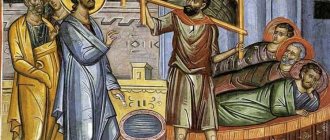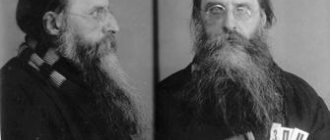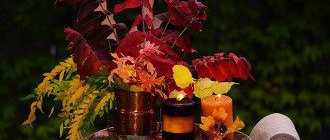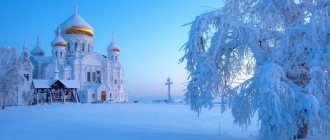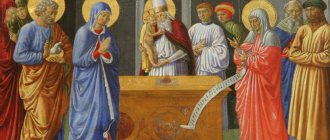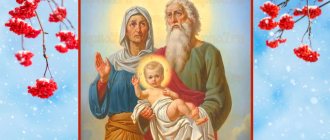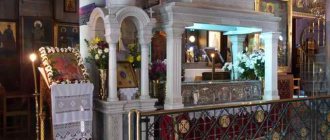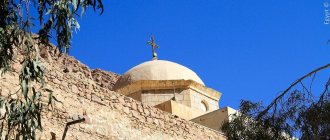Angel Day, May 9, male and female names
According to the Orthodox church calendar, May 9 marks 8 name days: 7 for men and 1 for women. The list of name days will help you choose a name for a boy or girl born on this day.
Name day is celebrated on May 9
Men
Basil from the ancient Greek name Basileios - “royal, royal”
Ivan from the Hebrew name Yochanan - “Yahweh is merciful” from the Hebrew John - “merciful of God”
Nestor from the ancient Greek name Nestor, which comes from nosteo - “to return, to set off, to leave safely”
Nicholas from the ancient Greek name Nikolaos - “conqueror of nations”
Peter from the ancient Greek name Petros - “stone”, “solid”, “reliable”
Stepan from the ancient Greek name Stefanos - “wreath, crown”, “crown”
Yang Polish, Belarusian and Old Russian forms of the Hebrew name Yochanan - “Yahweh is merciful”
Women
Glafira from the ancient Greek name Glafyura, which comes from glafure - “smooth”, “graceful”, “beautiful”
The history of the origin of the Orthodox church holiday of Glafira Goroshnitsa
The righteous woman lived in the 4th century and was a servant of the wife of the Roman Emperor Licinius. The emperor was distinguished by his tough law and quarrelsome character. He did not like science, had a negative attitude towards the opinions of others and did not tolerate objections. However, under With the pressure of his wife, in 331 he issued a decree on a tolerant attitude towards all religions, especially Christianity.
The emperor categorically disagreed with the signed document, but was forced to do so in order to increase his rating in the eyes of the people and strengthen his position as a competent and wise ruler. Licinius hated Christians in his soul and fought against them in every possible way.
Seeing the beauty of his wife's maid, the emperor wanted to take her as a concubine. The girl told her patron about her husband’s harassment. Licinia's wife took the side of her maid and decided to help the girl escape. She dressed Glafira in men's clothing and sent her to Armenia. The emperor was told that the girl had gone mad.
Glafira did not reach the intended settlement and stopped in Amasia with the local priest Vasily. He gave the girl shelter and food. For this, she gave all her savings, received from her patroness for the journey, to the construction of the temple.
However, this money was not enough, and the blessed one wrote a letter to her mistress asking for money. However, the letter falls into the hands of the emperor, and he enragedly gives the order to return the girl back, and to bring the priest Vasily with her. But this was not destined to come true, since the Lord did not allow the emperor to mock the unfortunate girl. Shortly before the arrival of Licinius's servants, Glafira died.
Vasily was tried. At trial, he refused to change his religion, for which he was sentenced to painful death. He was beheaded and his body thrown into the sea so that Christians could not bury his remains in accordance with Christian traditions. However, the priest’s companions nevertheless caught the remains of the martyr and gave them to burial. Subsequently, his relics were transferred to the church he built.
Red Hill, 3 most correct holiday dishes
In the Ryazan province, Krasnaya Gorka was also considered a girls' holiday. There it was customary for the girls to cook scrambled eggs in the morning, for which the ingredients were pooled together.
We have recipes for several scrambled eggs that are worth checking out. We decided to offer to cook them for Krasnaya Gorka. In the Ryazan province they certainly didn’t cook like that, but where are those provinces, and where are we...
Scrambled eggs “in the cloud” for the celebration of Krasnaya Gorka 2021
Unusual – fluffy – scrambled eggs. To ensure that the taste of the protein does not disappoint, add finely chopped herbs and a little lemon juice.
Scrambled eggs "in the cloud"
To prepare 4 servings you need:
- 1 egg
- 10 g butter
- salt
- Grease the pan with butter.
- Separate the whites from the yolks. Beat the egg whites until stiff peaks form, along with a pinch of salt.
- Pour the whites into the frying pan, carefully place the yolk in the center and add salt.
- Preheat the oven to 180°C.
- Bake in a preheated oven for 10 minutes. or longer, if desired.
Scrambled eggs in avocado
This is not just scrambled eggs with avocado, but avocado with egg filling. It seems like little things, but it looks so beautiful! A real work of culinary art, and ready in just 15 minutes. Recipe courtesy of Avocado Queen Restaurant.
Scrambled eggs in avocado for the celebration of Krasnaya Gorka
To prepare 4 servings you need:
- 4 avocados
- 4 eggs
- 100 g cherry tomatoes
- 60-70 g butter + for frying
- juice of a lemon slice
- green onions and hard cheese for serving
- salt, freshly ground black pepper
- Cut each avocado so that its 1 cm thick part (with the hole from the pit) remains intact.
- Fry the avocado “steaks” on both sides with a minimum amount of oil. Break the eggs into the holes from the pit.
- Mash the remaining avocado with a fork, sprinkling it with lemon juice.
- Fry the cherry tomatoes on all sides with a minimum amount of oil.
- Melt the butter and mix with lemon juice. Stir and, if desired, add literally 1-2 tsp. drinking water. Season with salt and pepper. Grind the fried tomatoes in a blender bowl, add the prepared tomato mixture. Punch until emulsion consistency is reached.
- Place the finished scrambled eggs in avocado on plates, pour over tomato sauce and add mashed avocado. Sprinkle with finely chopped green onions and grated Parmesan.
Saint Stephen, Bishop of Perm (Velikoperm)
Memory of Saint Bishop Stephen - the enlightener of Perm. Years of life: 1340-1395. He was ordained to the rank of hierodeacon and hieromonk. He built a temple in honor of Archangel Michael, St. Nicholas, and several monasteries. Converted the Zyryans to the Christian faith. Since 1383 - Bishop of Minor Perm.
Born around 1340 in the city of Ustyug in the family of the cleric Simeon. When the future mother of the saint, Mary, was still three years old, the Ustyug Saint Procopius the Fool foretold her the birth of a holy son. Under the influence of his pious mother, possessing great abilities, Stephen from a young age showed extraordinary zeal for serving the Church: in one year he learned to read and helped his father in church during divine services, fulfilling the position of canonarch and reader.
In his youth, the saint accepted monasticism in a monastery in honor of St. Gregory the Theologian in Rostov. The monastery was famous for its rich book collection. Saint Stephen wanted to read the Holy Fathers in the original and for this he studied Greek. In his youth, helping his father in church, he often talked with the Zyryans. Now, having mastered the rich church culture, Saint Stephen was eager to convert the Zyryans to Christ.
To educate the Zyryans, the future saint compiled the alphabet of their language and translated several church books into it. To compile the Zyryan alphabet, he used the Zyryan money badges, which they carved on thin quadrangular sticks (passes). Rostov Bishop Arseny (1374-1380) ordained him to the rank of hierodeacon. Having prepared himself for missionary activity, Saint Stephen appeared in Moscow in 1379 to Bishop Gerasim of Kolomna, who was then managing the affairs of the metropolis, and asked him:
“Bless me, Master, to go to the pagan country - Perm. I want to teach the holy faith to unfaithful people. I decided to either lead them to Christ, or lay down their heads for Christ.”
The bishop joyfully blessed him and ordained him to the rank of hieromonk. He provided him with antimensions, holy myrrh and liturgical books, and Grand Duke Dimitri Ioannovich gave him letters of safe conduct.
From Ustyug, Saint Stephen descended along the Northern Dvina to the confluence of the Vychegda, where the Zyryan settlements began. He was met with extreme hostility: they laid out a fire of wood, and they wrapped him in straw to burn him; but no one dared to approach him with a lit torch. His meek appearance and fearlessness disarmed the Zyryans, and they themselves began to ask him to preach to them. The preacher of the faith of Christ endured much labor, struggle, hardship and sorrow, living among the pagans who worshiped idols, “fire, water, trees, stones, and the golden woman, and the magician, and the sorcerer, and the tree.”
The Zyryans were especially in awe of the so-called “sweet birch tree.” A birch tree, enormous in thickness and height, grew on an elevated place. The Zyryans gathered to her and sacrificed the animals they had caught. Saint Stephen set up his cell not far from the birch tree and used the meetings of superstitious pagans around the tree to teach them the holy truth. Saint Stephen then cut down and burned the birch tree to eradicate superstition. The Zyryans were going to kill him. The saint addressed them with a sermon:
“Judge for yourselves, are your gods strong when they cannot protect themselves from fire? Are they gods when they are so weak and lack not only sense, but also hearing and sight? And your deity was unable to protect itself from me, the weak one. Are not all your other gods like this? This is not the Christian God. He sees everything, knows everything and is Almighty, for he created the whole world and provides for everything. And how good He is, especially to those who know Him! I wish you well by preaching the True God to you. He will love you and do good to you when you begin to honor Him sincerely.”
On the site of the “weedy birch”, Saint Stephen built a temple in honor of Archangel Michael, the destroyer of the spirits of darkness.
The baptized Zyryans themselves began to destroy what they had previously worshiped: they cut down sacred trees, crushed idols; They brought rich gifts intended for pagan altars to Saint Stephen. He ordered the Zyrian resident Matthew, who served with him, to set everything on fire and only allowed the linen to be used for wrapping the legs.
But the final turning point in the Zyryans occurred after Saint Stephen disgraced their chief priest Pam, who rebelled against the spread of the holy faith. The priest entered into an argument with Saint Stephen.
“You Christians,” said Pam, “have one God, and we have many helpers both on land and on water, giving us happy fishing in the forests and supplying Moscow, the Horde and distant countries with its abundance; they tell us in sorcery secrets that are inaccessible to you.”
Saint Stephen answered that there is only one True God; Omnipotence is one thing, but the powerlessness of the idol gods is obvious from experience. After much debate, the priest Pam, in order to justify his faith, volunteered to go through fire and water and demanded the same from Saint Stephen.
“I do not command the elements,” Saint Stephen humbly answered, “but the Christian God is great: I am going with you.”
Pam trembled and begged to be spared from certain death.
“You are witnesses,” Saint Stephen said to the assembled people, “he himself demanded that the dispute about faith be resolved by fire and water, and yet he does not want to be baptized. Who should we consider Pam to be now? What to do with him?" “The deceiver must be put to death,” the people answered, “if you let Pam go, he will do dirty tricks on you.” “No,” answered the saint, “Christ did not send me to put anyone to death, but to teach. Pam does not want to accept the saving faith, let his stubbornness punish him, but not me.”
Pam was kicked out. In gratitude to the Lord for the victory over the leader of the pagans, Saint Stephen built a temple on Vishera in honor of Saint Nicholas. After this, the saint’s preaching about Christ began to become more and more successful.
In 1383, Saint Stephen was installed by Metropolitan Pimen as Bishop of Perm. As a loving father, he tirelessly cared for his flock. To confirm the faith of converts, Saint Stephen opened schools at churches where sacred books were studied in the Permian language. The saint looked closely at the students, took into account their abilities in order to appoint priests and deacons from them. Saint Stephen taught some students to write in Permian.
The saint built churches in which he appointed priests from the Zyryans, and introduced worship in the Zyryans language. Saint Stephen translated into the Zyryan language the Book of Hours, the Psalter, selected readings from the Gospel and the Apostle, the Book of Paremias, the Stichirarion, the Octoechos, several festive services and the Divine Liturgy.
During crop failure, the Saint supplied the Zyryans with bread, many times delivered them from violence and bribes of the tiuns, eased their taxes, protected them from attacks by other tribes, interceding for them in Moscow. The fruit of his exploits and virtues was the conversion of the entire vast Perm land to Christianity - he himself baptized the population of Little Perm (later - the Komi region, i.e. the Vychegda River basin), and then the Faith was spread by his students and followers. This great deed was accomplished by the power of faith and Christian love. The life of the saint is a victory of faith over unbelief, of love and meekness over malice and wickedness.
Touching is the “absentee meeting” of St. Stephen of Perm with St. Sergius of Radonezh, which took place in 1390 during the saint’s trip to Moscow on church affairs. Saint Stephen passionately loved the Radonezh ascetic and really wanted to see him on his way from the Perm land, but he could not do this due to lack of time. Being 10 miles from the monastery of St. Sergius, Saint Stephen, having prayed, turned towards the monastery and said with a bow:
“Peace be with you, spiritual brother!”
The Monk Sergius, who was sitting with the brethren at the meal, stood up, prayed and, bowing in the direction where the saint was passing, answered:
“Rejoice, you too, shepherd of the flock of Christ, and may the peace of God be with you!”
The deep spiritual connection between St. Stephen of Perm and St. Sergius of Radonezh is now evidenced by the special daily prayer to them at the fraternal meal.
In addition to establishing churches, Saint Stephen founded several monasteries for the Zyryans: Spasskaya Ulyanovsk hermitage 165 versts from Ust-Sysolsk, Stefanovskaya monastery 60 versts from Ust-Sysolsk, Ust-Vymskaya Arkhangelsk, Yarenskaya Arkhangelsk.
Saint Stephen is also credited with painting several icons. The most famous of them is the “Zyryan Trinity” with an extensive inscription in the Stefanov alphabet in the Komi language.
In 1395, Saint Stephen again went to Moscow on business for his flock and died here. His body was laid in the monastery of the Savior Behind the Wall (in the temple on Bor in honor of the Savior) in the Moscow Kremlin. The Zyryans bitterly mourned the death of their apostle. They strenuously begged the Moscow Prince and Metropolitan to release the body of their mentor to Perm, but Moscow did not want to part with the remains of the great saint.
The glorification of Saint Stephen began at the beginning of the 15th century. The life was written shortly after the death of the saint in 1472. The service for him was composed by Hieromonk Pachomius the Serb with Hieromonk Epiphanius the Wise, a disciple of St. Sergius of Radonezh, who knew the saint well and loved to talk with him.
Venerable Ioannikis of Devichensky
Feast of the Holy Venerable Ioannikios. He labored in the Devichenskoye Forest. He had the gift of healing.
The December commemoration of St. Ioannikios, unfortunately still not included in Russian monthly calendars, was celebrated yesterday in the vastness of long-suffering Kosovo and Metohija - and where there are more living Serbs than those who have departed, and especially in places where there are more deceased, because they, It is easier for martyrs to remember God and His saints than for us who observe earthly vanity. But still, the few minutes that will pass in the memories of our venerable father Ioannikis, I hope, will bring us closer to our brothers, whose souls are in the hand of God (Prem. Sol. 3.1).
The Monk Ioannikios, who lived in the Black River Monastery, and also in complete solitude, in the trunk of an old beech tree, became famous at a time when the body of the Serbian state became weak, but the spirit remained vigorous (Mark 14.38), when the Athonites, Sinaiites and ascetics of Prizren and Gračanica spread the “smart practice” of the Jesus Prayer, laying up treasures for themselves in heaven (Matthew 6.19), while teaching the simpleton strength in the Faith and national self-awareness. According to one legend, St. Ioannikios was a native of Metohija, according to another - Dioclea Primorskaya (Zeta), but, in any case, both he and his suffering monastery were and remain pillars of Serbia.
The time of his birth is the middle of the 14th century, when Serbia under Tsar Dusan became the strongest power in the Balkans. But already during the youth of the saint, after the murder of St. Urosh the Young and the Battle of Kosovo, the Serbian state began to disintegrate into fiefs and tend to decline. St. Ioannikios labored during the times of St. Despot Stephen the Tall and his heir Djuradzh Brankovich Smederevsky, whose son was related to the Tsar of Rus' John III. The daughter of Juraj, a girl, according to legend, was healed by St. Ioannikis from a serious illness - blindness or madness.
In gratitude for the healing of his daughter, the Despot built the Devich Monastery in 1434. The death of St. Ioannikis is assumed to be in 1430.
During its history, the Devich Monastery was repeatedly plundered and oppressed by the Turks, who defeated the Despotovina in 1459, as well as traitors to their Faith - Albanian-Turkish people.
The Chairman of the St. Petersburg Slavic Committee, and previously the Consul in the Balkans, Alexander Fedorovich Hilferding, describes Devich’s condition in 1857:
“The Monastery of St. Ioannikios of Devich is located five hours from Vucitrn, on the border of Dukadjin, in the parish called Drenica. We crossed the crumbling old bridge over Sitnica, which flows in low-lying meadows, and soon reached the mountains bordering the Kosovo field. For more than four hours we drove along the heights, now ascending, now descending, now following the direction of hollows overgrown with forest, and did not meet a village, a hut, or a human soul. Finally, in a clearing surrounded by forested mountains, we saw a monastery, surrounded by a rather high and strong wall.
We entered the monastery; I got off the horse and sat down on the divan-khan. Nobody came out to us. After many futile attempts, people reached out to some servant and sent him to tell the abbot about our arrival. We waited for a long, long time for the abbot... He only told me that the monastery suffers from the Albanians, who make up the population of the entire surrounding area, and has very little income, because the Albanians took away its former possessions, and there are very few admirers, although the relics of St. Joannicius are greatly enjoyed respect among the people; but the monastery lives in such a wilderness that few dare to go there...
The monk, who together with the abbot and another monk made up the entire brethren of the Devish monastery, began to tell me... about how St. Ioannikis, the son of rich parents, fled from his father’s house to retire from the world, and lived for a long time in complete obscurity and solitude in the forest where the monastery now stands; how the people, little by little, began to learn about his exploits and flock to him; how Yuri Brankovich, Sovereign of Serbia, having heard about his miracles, brought his blind daughter to him, and he restored her sight by washing her eyes with water from a source, which is now shown near the monastery; how Ioannikiy, constantly troubled in his solitude, retired to the Chernoretsky Mountains and moved into a cave there... Poor abbot Paisius... Three weeks later, I had just returned to Sarajevo, they wrote to me that the abbot was shot by the Albanians...”
Modern eyewitness Natalia Batraeva writes:
“The Devich Monastery was founded in 1434 on the spot where the 15th-century hesychast Saint Ioannikis of Devich labored in an empty beech tree trunk. The monastery is located in dense forests, five kilometers from the town of Srbica. The ktitor - despot Djurdzh Brankovich - built the monastery as a token of gratitude for the cure of his sick maiden daughter. This is where the name Devich came from.”
During the Turkish yoke, the monastery was repeatedly desecrated, burned and destroyed, but was invariably restored and reconstructed.
Today in Devich there are several churches: the Entry into the Temple of the Blessed Virgin Mary, St. Ioannikios and St. George. They preserve three layers of fresco painting: from the 15th, 16th and 19th centuries. Previously, the monastery had a rich collection of books, copied in its own workshop, which were stored here for centuries.
In 1941, during the Italian occupation of Kosovo, churches and cell buildings were looted and blown up by Albanian Nazis (Hegumen Damaskin (Boškovich), like his predecessor Paisius, was killed by the Albanians - A.P.). All the ancient books and the iconostasis with ancient icons burned in the fire. The cave of St. Ioannikis of Devich, located on a hill north of the monastery, was also destroyed.
In 1950 (according to other sources - in 1947), Devich, more like a pile of stones, was restored through the efforts of Mother Superior Paraskeva and the sisters.
In 1999, immediately after the withdrawal of the Yugoslav army from Kosovo and the arrival of the French KFOR contingent in the Srbica area, Albanians, members of the KLA, broke into the monastery. From July 12 to July 14, the occupation of the monastery lasted. For three days the shrine was desecrated and plundered. The nuns, together with their confessor Father Seraphim, became prisoners, and all this time they were subjected to physical and moral abuse. As a result, Father Seraphim was beaten, and one of the bandits forced his youngest sister to take off her apostle, to which she responded with a decisive refusal.
From 1999 to 2002, the monastery was guarded by Russian troops; their military base was located nearby. During this time, about thirty Russian soldiers were baptized in Devich.
On March 18, 2004, in the wake of the terror that swept Kosovo and Metohija, the monastery was again destroyed. The military, under whose protection Devich was, evacuated the nuns and allowed the Shiptars to enter unhindered. After this, the monastery was completely burned, the tomb of St. Ioannikios of Devich was opened and desecrated (the Albanians lit a fire in it).
When the military began to evacuate the nuns of the monastery, in the chaos they forgot the eighty-year-old nun who witnessed what was happening. Here's what Angelina's mother said:
“It was about four o’clock in the afternoon when I, tired, came from the garden and said that I would not go to lunch. I felt bad (as if in anticipation of something bad) and dozed off. I don’t know how much time passed, I was awakened by screams and noise. Getting up, I saw that there was no one around, and only a prolonged howl was coming from somewhere (perhaps the sound of sirens - author's note). An army in black began to fill the monastery through the destroyed gates. It was UAC. And I thought that I had just given my soul to God!”
The sisters, evacuated by helicopter, soon noticed the absence of Angelina's mother. They asked the soldiers to return. In the evening, the nun was taken to the KFOR base in Srbica, and from there she was transported to the Kosovska Mitrovica hospital. But even after a year, Mother Angelina said that she still sees before her eyes an angry crowd shouting calls for an attack, and fire consuming wood and stone.
After some time, the sisters returned - only burnt walls remained from Devich. Churches, cells and outbuildings were looted, burned and destroyed. Monastery valuables: church bells, historical books, crosses and much more were stolen. The water supply and sewerage systems have been destroyed. The heating system has been dismantled. The monastery's cattle are stolen.
The shrine was again restored by the nuns with the help of the French and Spanish military.
Currently, five sisters live in the monastery, who cultivate the monastery lands on their own.
The greatest spiritual treasure of Devich is still the relics of St. Ioannikios, which are kept under wraps. He is especially loved by the Serbian people as a great miracle worker and healer, through whose prayers MANY miracles still happen today. One of them is the invisible presence and intercession of Saint Ioannikios for his monastery. After all, only by the clear grace of God is the repeatedly desecrated and destroyed monastery revived again in order to dispel the pitch darkness surrounding it with its unquenchable light.
Saints' Day according to the Orthodox calendar
According to the church Christian calendar, yesterday May 9, 2020 is the day of remembrance of saints:
- Hieromartyr Basil of Amasia, bishop
- Venerable Ioannikiy Devichensky, Chernoretsky, Serbian
- Glafira of Amasia, maiden
- Hieromartyr John Pankov, presbyter
- Martyr Nicholas (Pankov)
- Martyr Peter Pankov
- Saint Stephen of Perm (Great Perm), bishop
The days of remembrance of saints according to the church calendar are taken as the basis when choosing a name for a person’s baptism. In accordance with them, a person’s Christian name day or, more simply put, the day of an angel is determined. In Orthodoxy, it is customary to honor the memory of one’s saint through prayer.
Signs for the weather
- cloudless skies and warm weather - to a rich grain harvest
- rain will make the land fertile
- if there are many birds flying near the place of celebration, the year will be fruitful
- rainy weather - for the imminent birth of the newlyweds' first child
- if the day is calm and warm, there will be a good wheat harvest
- the birch is covered with leaves, but the alder is not - the summer will be hot and dry
- cool weather - hail in July
- no stars are visible in the sky at night - the month will be warm and cloudy
- the night was clear and starry - for a bountiful harvest of vegetables
- thunderstorm - for warm weather
- the oak tree is covered with leaves - frosts are still ahead
- if there is no rainbow in the sky after the rain, the bad weather will last for several days
- cobwebs flying in the air - to drought in summer
- a lot of midges and mosquitoes - to a rich harvest of berries and mushrooms
